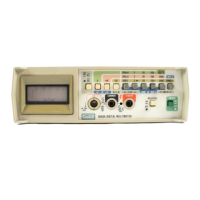2.
Connect the
8050A to the Voltage Standard
as
follows:
V
/kO/S
input connector
to
the
Voltage Standard
Hi
output,
COMMON
input
connector to the Voltage Standard low output.
3.
Select
the
V
function
(either
ac
or
de,
depending upon the Voltage Standard used).
4.
Adjust the Voltage Standard to output the
reference level calculated in step
1.
This value
should appear in the
8050A display.
5.
Select the dB function.
6.
Set the RELATIVE switch to
ON. Decibel
measurements will now be referenced to the
circuit impedance.
2-48.
Use the following procedure to obtain a correction
factor for referencing dB to other circuit impedances
without the use of a Voltage Standard:
1.
Select
the
REF
Z
that
is
closest to the
impedance of the circuit to be measured.
2.
Calculate the reference impedance correction
factor using the following equation.
Circuit Impedance
10
log
REF
Z
=
Correction Factor
3.
Add the correction factor to the measured
value.
2-49.
CIRCUIT LOADING ERROR
(VOLTAGE)
2-50.
Circuit
loading
errors
occur
when voltage
measurements are taken on high impedance circuits. This
is
because the DMM loads the source, thus changing the
operating voltage of the source.
As
long as the circuit
impedance (source impedance)
is
low compared to the
input impedance
of
the
DMM
this
error
may be
insignificant. For example, when measuring a circuit with
a source impedance of 1
kO or less, the error will
be~
.01
%.
If
the circuit loading error
is
significant, use the
appropriate formula contained
in
Figure
2-10
to calculate
the percentage of error.
2-51. Current Measurement
2-52. The following paragraphs contain additional
information on and measurement techniques for current
measurements.
OPERATION
RESISTANCE
MEASUREMENT
WARNING
OPERATOR INJURY
AND
INSTRUMENT
DAMAGE
MAY
RESULT IF
THE
BACKUP
FUSE
(F2)
BLOWS
WHEN
CURRENT IS
BEING MEASURED
FROM
A VOLTAGE
OF
GREATER
THAN
600 VOLTS.
2-53.
BURDEN VOLTAGE ERROR
2-54.
When a multimeter
is
placed in series with a circuit
to measure current, the voltage drop of the multimeter
induces an error. This error
is
called the burden voltage.
The maximum full-scale burden voltages for the
8050A
are
0.3V
for the four lowest ranges and
0.9V
for the
highest range.
2-55.
These voltage drops can affect the accuracy
of
the
current measurement if the current source
is
unregulated
and the resistance of the shunt and fuses
of
the multimeter
exceeds 1 /
1000
of
the source resistance.
If
the multimeter
burden voltage
is
significant, the formula in Figure
2-11
can
be
used to calculate the burden voltage error.
2-56. Resistance Measurement
2-57. The following paragraphs contain additional
information
on
and
measurement
techniques
for
resistance measurements.
1.
DC
VOLTAGE
MEASUREMENTS
Loading
Error
in%=
100
x
Rs
7
(Rs+
10
7
)
Where:
Rs=
Source
resistance
in
ohms
of
circuit
being measured.
2.
AC
VOLTAGE MEASUREMENTS
First,
determine
input
impedance, as
follows:*
10
7
Zin=
V1
+
(2
n
F
·
Rin · Cin)
2
Where: Zin
=effective
input
impedance
Rin =
10
7
ohms
Cin
=
100
x
10 ·
1
2
Farads
F =
frequency
in
Hz
Then,
determine
source
loading
error
as
follows:*
·
E
Zs
Loading
rror in %
=
100
x Zs + Zin
Where:
Zs=
source
impedance
Zin =
input
impedance
(calculated)
*Vector
algebra
required
Figure
2-10.
Circuit Loading Error
2-13

